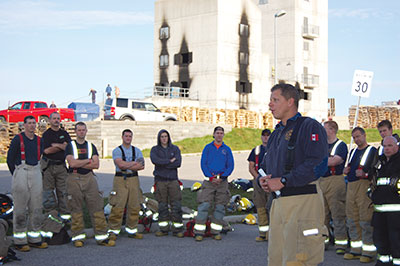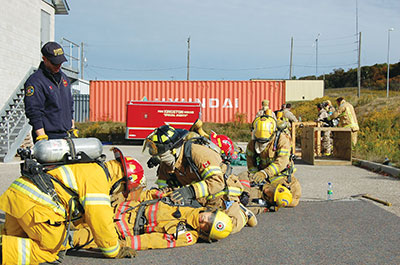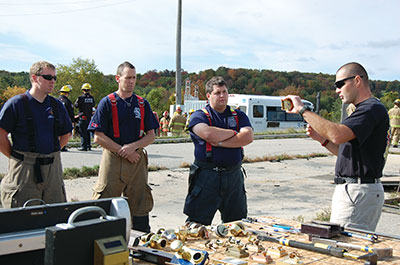
Features
Structural
Training
Trainer’s Corner: June 2013
I have the honour of instructing at FDIC Atlantic in Wolfville, N.S., again this year.
June 4, 2013
By Ed Brouwer
I have the honour of instructing at FDIC Atlantic in Wolfville, N.S., again this year. My son Casey and I will be travelling to Nova Scotia, the province where the Canadian fire service got its start. Although fire brigades can be traced back to the Roman Empire, it was in 1754 that the Union Fire Club was formed in Halifax, effectively becoming the first organized fire department in Canada; it became the Union Engine Company in 1768. In 1996, the municipalities of Halifax, Dartmouth, Bedford and Halifax County amalgamated to form the Halifax Regional Municipality (HRM); 38 fire departments joined to become the Halifax Regional Fire & Emergency Service.
 |
|
| Finding and keeping firefighters is difficult for volunteer departments. Keep your firefighters engaged by training them in the basics. Photos by Olivia D’Orazio |
So, here we are some 250 years later and one thing is certain: a lot has changed. Change is inevitable, and change is good, but I fear we have become the victims of change. The demands and expectations placed on the fire service, particularly the volunteer departments, have changed and continue to change at an ever-increasing rate.
The Canadian fire service must be the agent of positive change, not the victim of inevitable change. We must keep up with the changes around us while protecting our greatest resource: the volunteer firefighter.
 |
|
| The Canadian fire service must be able to keep up with the changes around it while protecting its greatest resource – the volunteer firefighter – through ongoing training. |
|
 |
|
| Volunteer departments don’t have the luxury of having specialty task groups. Every member must be trained to the same level, because you never know who will be able to respond. Advertisement
|
I am not talking about living in the past, or about living in the present while pretending it is the past. Yes, at one time all we did was put the wet stuff on the red stuff. We have changed, the demands on us have changed, expectations of us have changed, and technology has changed. If we don’t step up and change with these things, we will become antiquated. Worse yet, there is a risk of not adequately preparing the next generation of volunteers.
Volunteer fire departments are always just one generation away from extinction. It’s our job, as training officers, to make sure our firefighters are prepared not just for today, but for the future.
Many departments struggle to keep their doors open due to such issues as lack of funding and shortage of volunteers. But there is another concern: volunteers may be in jeopardy of becoming overwhelmed, not by fire-related tasks, such as structural and wildland fire fighting, but by myriad additional training requirements, such as first response medical, extrication, hazardous materials response, and as witnessed in recently in Boston, terrorism.
It is not unusual for volunteer firefighters to spend hours at a structure fire or, depending on location and resources, a complex MVC, and then go to their day jobs. However, is it reasonable to expect a volunteer firefighter to spend six to eight hours flagging, which has been the case lately in our region? How much more can we expect from our volunteers?
With ever-tightening purse strings on the training budget and fewer grains of sand in the hourglass, these extra assignments could end up exhausting us. Each volunteer department must stay true to its mandate and guard its members by not taking on too much. Sometimes, it is better to say no. Do not take on more responsibility than you can handle and don’t agree to commitments that you can’t keep.
So, how do we prevent our members from becoming overwhelmed?
A good place to start is by clearly expressing your department’s mandate; be sure each member understands it and then train to meet that mandate. Print the mandate on business cards and give one to each member. For example, the mandate of the Campbell River Fire Department in British Columba is to minimize loss of life and property for the City of Campbell River from fires, natural disasters, life-threatening situations, and to assist other emergency agencies.
Remember, our greatest resource is the firefighter. Keep firefighters engaged in this worthy calling by training them in the basics. Volunteer Training Drills, by Howard A. Chatterton, quotes Chief Ramon Granados of the Bowie Volunteer Fire Department and Rescue Squad in Maryland, who often said, “The public will probably forgive you if you have trouble with a difficult fire, but they will never forgive you if you don’t do the basics right.”
Give your members something to be proud of, raise the bar and stay on point. Leave the politics to the politicians. Ask yourself, “What if volunteers, didn’t volunteer?” Familiarize yourself with the Volunteer Firefighters Bill of Rights – several versions can be found online.
As a volunteer it is your right:
- To be assigned a meaningful task
- To be oriented, trained and supervised for the duration of your activity
- To ask questions about your task and seek feedback about your performance
- To be treated with respect and kindness at all times, by every member of the organization for which you volunteer
- To offer input to and feedback from the organization about the job or task you are performing, in an effort to improve your performance and the state of the volunteer fire service
- To be trusted with confidential information, which may be necessary to fulfill your task
- To expect that your time will be used efficiently and effectively
The following is a breakdown for a full year of training, divided into the four seasons with 12 practice sessions per unit. This may not meet your specific training requirements, but it is a good place to start. Customize it to suit your needs.
When all is said and done, the above schedule constitutes more than 96 hours of training per firefighter, plus an additional 96 hours for the training officer to prepare. These are just the basics of fire training. We have not even begun to touch on first response medical, flagging, hazmat, terrorism, extrication, swift water rescue and high angle rescue, among others. Yes, you can do these on weekends, but these skills must be practised during the year and many require annual recertification. I’m not trying to discourage you, but volunteer departments don’t have the luxury of having specialty task groups. Every member must be trained to the same level, because you never know who will be able to respond. Be careful that you don’t bite off more than you can chew. It is much safer for your members to be proficient at one or two tasks, than inept at a dozen.
I have a huge appreciation and respect for the 127,000 volunteer firefighters in Canada. These men and women deserve to be well trained and given the utmost respect. Trainer’s Corner was birthed 11 years ago with the intent to help meet the needs of the volunteer training officer, so if I can help you in any way, please contact me. Perhaps it would do us all good to get back to meeting our mandates.
Until next time – stay safe and remember to train like lives depend on it.
|
Ed Brouwer is the chief instructor for Canwest Fire in Osoyoos, B.C., and Greenwood Fire and Rescue. Ed has been in the fire service for 25 years, 18 of those as an instructor. He is a fire warden with the B.C. Ministry of Forests, as well as a wildland urban interface fire suppression instructor/evaluator. He has recently been ordained as a disaster response chaplain. Contact Ed at aka-opa@hotmail.com
Print this page